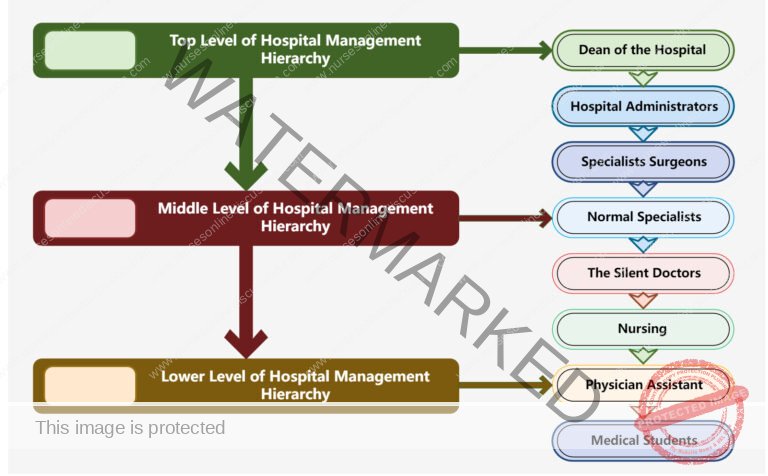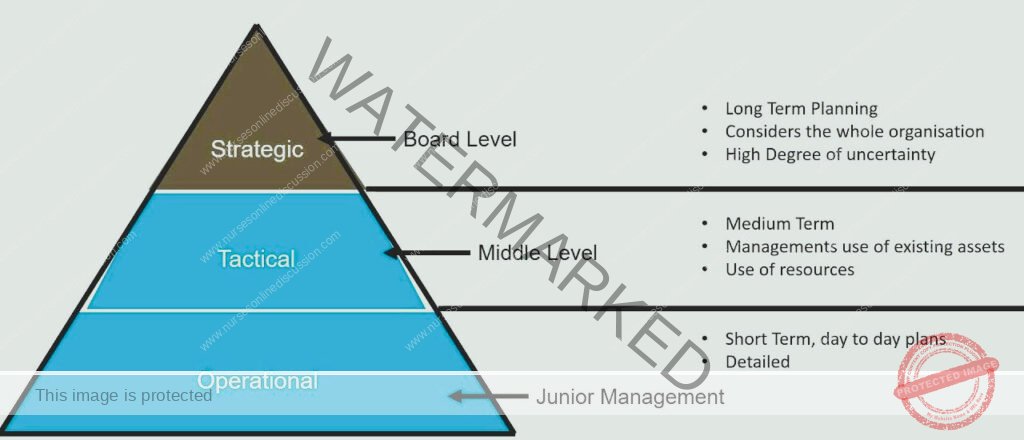Management
Subtopic:
Levels of Hospital Management
Levels of Hospital Management describe the hierarchical structure of managerial roles within a hospital setting.
As a hospital grows in size and personnel, the layers of management tend to increase, and conversely, smaller hospitals may have fewer management levels. These levels define the chain of command, the scope of authority, and the degree of decision-making influence held by various managerial positions.
Hospital management levels are broadly categorized into three main tiers, each directing managers to perform distinct sets of functions.

1. Administrative, Managerial, or Top Level of Hospital Management:
This uppermost tier comprises the hospital’s governing body, such as the board of directors, along with executive leadership like the chief executive officer (CEO) or medical director.
It represents the ultimate source of authority and decision-making power, responsible for defining the hospital’s overarching goals, policies, and operational frameworks. Their primary focus is on strategic direction and ensuring the long-term success of the hospital as a whole.
Key Roles & Responsibilities of Top-Level Management:
Objective Setting: Defining the overall goals and establishing broad policies for the hospital organization.
Budget & Procedure Guidance: Issuing necessary instructions for departments to prepare their specific budgets, schedules, and operational procedures.
Strategic Planning & Policy Development: Creating long-range strategic plans and overarching policies to guide the hospital’s future.
Executive Appointments: Selecting and appointing departmental managers who form the middle management level.
Establishing Organizational Controls: Implementing control mechanisms across all hospital departments to ensure accountability and performance.
External Communication & Accountability: Serving as the primary point of contact with external stakeholders and being accountable to them for the hospital’s overall performance.
Guidance, Direction & Harmony: Providing overarching leadership, setting the overall direction, and promoting a collaborative and harmonious work environment.
2. Executive or Middle Level of Hospital Management:
This level is composed of departmental heads and branch managers.
These managers are directly answerable to top management for the effective operation of their respective departments. They dedicate a significant portion of their time to organizational tasks and providing direction within their areas. Larger hospitals might have multiple layers within middle management, distinguishing between senior and junior middle managers, while smaller hospitals might have a single layer.
Key Roles & Responsibilities of Middle-Level Management:
Plan Execution: Putting hospital-wide plans into action within their departments, adhering to policies and directives from top management.
Sub-Unit Planning: Developing detailed operational plans for their specific departments or units, aligned with broader hospital strategies.
Lower-Level Staffing & Development: Participating in the recruitment and training processes for supervisory and operative level staff.
Policy Interpretation & Communication: Clarifying and explaining top-level policies to managers at the lower levels to ensure understanding and implementation.
Reporting & Data Provision: Preparing and submitting timely and accurate reports and data to top management, providing performance insights.
Performance Evaluation of Junior Managers: Assessing the performance of managers at the supervisory level and providing feedback.
Motivation & Performance Improvement: Encouraging and motivating lower-level managers to enhance their performance and contribute to departmental goals.
3. Supervisory, Operative, or Lower Level of Hospital Management:
This bottom tier of management includes supervisors, head nurses, section heads, superintendents, and other executives whose primary focus is on direct human resource oversight and guiding operational staff.
Essentially, lower-level managers are primarily focused on the daily execution and coordination of workflows to ensure smooth patient care delivery and that immediate operational targets are met.
Key Roles & Responsibilities of Lower-Level Management:
Task & Patient Assignment: Allocating tasks and assigning patient care responsibilities to individual staff members.
Guidance & Instruction: Providing direct guidance and instructions to staff on their daily tasks and procedures.
Quality & Quantity Oversight: Monitoring both the quality and volume of patient care delivered by their teams.
Maintaining Staff Relations: Fostering positive and productive working relationships within their teams at the lower levels.
Acting as a Communication Bridge: Serving as a conduit for communication, conveying staff concerns, suggestions, and feedback upwards to higher management, and in turn, explaining organizational goals and objectives to staff.
Grievance Handling: Assisting in addressing and resolving staff grievances and concerns at the operational level.
Subordinate Supervision & Guidance: Directly supervising, mentoring, and guiding their immediate subordinates in their daily work.
Staffing & Training Input: Participating in the hiring and initial training processes for new staff members joining their teams.
Resource Management at Operational Level: Ensuring the availability of necessary medical supplies, equipment, tools, and other resources needed for daily tasks.
Performance Reporting: Preparing regular reports on the performance and activities of their staff for higher management review.
Maintaining Workplace Standards: Enforcing discipline, upholding professional standards of conduct, and fostering a harmonious workplace environment.
Public Image Contribution: Contributing to a positive hospital image through their direct interactions with staff, which indirectly impacts overall hospital perception.
Functions of management.
Henri Fayol outlined core management functions that are still relevant today. These include:
Planning
Organizing
Directing (or Leading)
Staffing
Controlling
Building on Fayol’s work, Luther Gulick, in 1937, further detailed executive/managerial functions with the acronym POSDCORB, encompassing: Planning, Organizing, Staffing, Directing, Coordinating, Reporting, and Budgeting. Management can be broadly understood through these universally applicable functions.
Planning
In management, planning is the foundational function that involves anticipating future needs and demands. It is about defining desired outcomes by setting clear objectives and then creating strategies and action plans to achieve them. Planning is the initial and most critical management function, serving as the basis for all subsequent actions.
Planning is fundamentally a decision-making activity. It’s the process of:
Establishing clear objectives.
Determining the specific steps and actions needed to reach those objectives.
Planning is also about proactively preparing for change and managing uncertainty. It involves:
Forecasting future conditions.
Developing strategic courses of action to navigate these future conditions.
Planning is especially vital because resources are limited, the environment is often unpredictable, and there’s competition for available resources.
Reasons for Planning/Purpose of Planning:
Goal Achievement: To effectively realize organizational goals and objectives through well-defined strategies.
Effective Resource Use: To ensure resources, especially human resources, are utilized efficiently, minimizing waste.
Crisis Preparedness: To better handle unexpected situations and crises by anticipating potential issues and developing contingency plans.
Resource Control: To maintain effective control over resources, particularly human resources, ensuring they are directed appropriately.
Decision-Making Guidance: To provide a clear roadmap for decision-making by outlining the necessary actions to achieve goals, allowing for informed choices about present and future activities.
Problem Anticipation: To foresee potential problems and proactively set measures to ensure smooth and uninterrupted organizational operations.
Identify Improvement Areas: To pinpoint gaps and areas needing change through regular reviews, facilitating continuous organizational improvement and development.
Meaningful Work: To give purpose to employees’ work by aligning their efforts towards clearly defined and understood goals, enhancing motivation and direction.
Characteristics of a Good Plan:
Simplicity and Comprehensiveness: A good plan should be easy to understand yet sufficiently thorough to cover all essential aspects of operations required to meet the objectives. It should be readily grasped and actionable by all personnel while providing necessary detail.
Clear and Well-Defined Objectives: Objectives within a plan must be unambiguous, precisely defined, and easily understandable by everyone involved. Clarity in objectives ensures focused effort and consistent direction.
Balance and Flexibility: Effective plans need to be both balanced and adaptable. Resources should be appropriately allocated to ensure optimal use, preventing short-term gains at the expense of long-term goals. Plans should also be flexible enough to accommodate changes in resource availability or unforeseen circumstances.
Time-Bound: A well-structured plan has a specific timeframe associated with it. Defining a clear time period for the plan’s execution helps in tracking progress and maintaining focus.
Actionable: A good plan includes practical and achievable strategies for reaching organizational goals. The strategies outlined should be realistic and capable of being implemented effectively.
Subordinate Involvement: An effective plan integrates all relevant departments within the organization to foster unity and a shared focus on overarching objectives. This often requires involving subordinates in the planning process to ensure buy-in and collaboration.
Principles of Effective Planning:
Clear, Reasonable, and Attainable Aims: Organizational goals stated in the plan must be clear, practical, and achievable. Setting unrealistic goals can lead to failure and decreased motivation among staff.
Involvement of Subordinates: Engaging subordinates in the planning process is crucial. Their participation fosters plan acceptance and strengthens their commitment to successful implementation.
Assigning Planning Responsibility Appropriately: Planning tasks should be delegated to individuals who possess direct involvement in the relevant operations and have the necessary expertise for effective plan development.
Realism in Expected Outcomes: Planners should adopt a realistic outlook when anticipating results. Avoid excessive optimism, and instead, base plans on a grounded evaluation of the organization’s abilities and available resources.
Flexibility and Continuous Review: Plans should be designed to be adaptable and subject to ongoing review and adjustments as needed. The dynamic nature of the operational environment necessitates plans that can be modified in response to changing conditions.

Levels of Planning:
Strategic Planning/Long-Term Planning:
Who: Top Management (e.g., CEOs, Directors).
Timeframe: Long-range, typically up to 10 years.
Focus: Defining the overarching direction and future path of the organization. It involves a comprehensive analysis of the organization’s overall abilities, strengths, and weaknesses to set its long-term course.
Tactical/Intermediate Planning:
Who: Middle Management (e.g., Department Heads).
Timeframe: Medium-term, roughly 6 months to 2 years.
Focus: Translating broad strategic goals into more practical and achievable plans for departments and units. Middle managers take the high-level objectives and create detailed, workable plans to support them.
Operational Planning:
Who: Lower Management (e.g., Unit Supervisors).
Timeframe: Short-term, from 1 week up to one year.
Focus: Specific and detailed plans for day-to-day operations. Operational plans outline exactly how individual jobs and tasks will be carried out most effectively to support tactical and strategic plans.
Planning Process/Steps in Planning:
Assessment:
Action: Gather and analyze relevant information about the current organizational situation. This step aims to understand the organization’s current position, available resources, and desired future state. It answers questions like “Where are we now?” and “Where do we want to go?”.
Key Activities: Data collection, information analysis, identifying organizational needs, strengths, and weaknesses.
Establish and Clearly Define Goals/Objectives:
Action: Set specific, measurable, achievable, relevant, and time-bound (SMART) goals. Clearly define what the organization aims to achieve.
Key Components: Define the purpose of each goal and the expected outcomes. For instance, a hospital’s objective might be “to enhance the quality of patient care.”
Identify Resources:
Action: Determine the resources required to achieve each goal.
Key Consideration: Specify financial, human, and material resources needed for successful goal completion.
Priority Setting:
Action: Rank goals and resource allocation based on importance and urgency.
Key Approach: Focus on the most critical tasks first to ensure efficient resource utilization and progress toward key objectives.
Development of Strategies:
Action: Create detailed action plans and approaches to reach the defined objectives.
Key Elements: Establish timelines, assign responsibilities considering staff abilities, and develop policies and guidelines to manage organizational activities.
Implementation of the Plan:
Action: Put the developed plans and strategies into action. This is the execution phase where plans are carried out.
Key Requirements: Effective coordination of resources and skills to execute strategies and move towards organizational goals.
Evaluation of the Plan:
Action: Regularly review and assess the plan’s progress and effectiveness.
Key Activities: Monitor progress, measure results against objectives, identify deviations, make necessary adjustments and corrections to ensure the plan stays on track. Regular progress reports from departments can aid in this evaluation.
Get in Touch
(+256) 790 036 252
(+256) 748 324 644
Info@nursesonlinediscussion.com
Kampala ,Uganda
© 2025 Nurses online discussion. All Rights Reserved Design & Developed by Opensigma.co

